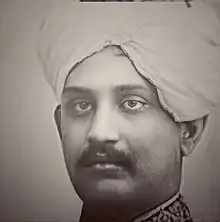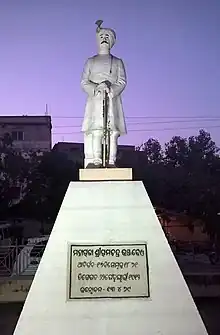Sriram Chandra Bhanj Deo
Maharaja Sri Rama Chandra Bhanja Deva (Odia: ମହାରାଜ ଶ୍ରୀ ରାମଚନ୍ଦ୍ର ଭଞ୍ଜଦେବ; 17 December 1870 – 22 February 1912)[1] was the Maharaja of Mayurbhanj State of India.[2][3]
Maharaja Shri Rama Chandra Bhanjadeo | |
|---|---|
ମହାରାଜ ଶ୍ରୀ ରାମଚନ୍ଦ୍ର ଭଞ୍ଜଦେଓ | |
 | |
| Born | 17 December 1870 |
| Died | 22 February 1912 (aged 41) Calcutta, Bengal Presidency, British India |
| Nationality | Indian |
| Spouses | |
| Children | Purna Chandra Bhanjadeo, Pratap Chandra Bhanjadeo, Dhrubendra Chandra Bhanjadeo, Jyoti Manjari Devi |
| Parent | Krishna Chandra Bhanjadeo |
| King of Mayurbhanj | |
| Reign | 29 May 1882 – 22 February 1912 |
| Predecessor | Krushna Chandra Bhanja Deo |
| Successor | Purna Chandra Bhanja Deo |
| House | Bhanja dynasty (Mayurbhanj branch) |
Personal life
Early life
Sriram Chandra Bhanj Deo was only eleven years old when his father, Maharaja Krishna Chandra Bhanj Deo, the ruler of the Mayurbhanj State, passed away. On 29 May 1882, Sriram Chandra Bhanj Deo succeeded to the throne. At that time, the State was under the Court of Words, governed by a British Commissioner P. Wylly, and the affairs of the state remained under the control of his grandmother, the Dowager Maharani of Mayurbhanj. On 15 August 1892, the Maharaja, having reached the age of 21, came of age and formally assumed the role of Maharaja.[3]
Matrimonial alliances
He was first married to Maharani Lakshmi Kumari Devi, daughter of a zamindar of Panchkot in Bengal, who died in 1902.[3] In 1904, he married Maharani Sucharu Devi, a daughter of Maharshi Keshub Chandra Sen. He had two sons, Purna Chandra Bhanj Deo and Pratap Chandra Bhanj Deo with his first wife.[3] Purna Chandra Bhanj Deo succeeded him to the throne, while Pratap Chandra Bhanj Deo succeeded his elder brother to the throne after the former's death.[3] He had a son, Dhrubendra Chandra Bhanj Deo and two daughters of his second wife, Sucharu Devi. Dhrubendra Chandra Bhanj Deo became an air force pilot and died in action during the Second World War.[4] The elder daughter was married to the Maharaja of Vizianagaram and the younger daughter, Rani Jyoti Manjari Devi was married to Mahant Sarveshwar Das, the Raja Bahadur of Nandgaon, a princely state of the erstwhile Central Provinces and Berar.[5]
Work
Administration
He worked for the all around development of Mayurbhanj and implemented various welfare schemes designed to help the people. He was revered as a philosopher king. He constituted the state council for administration in the state and brought about reforms in the sphere of language, health and administration.[7]
During his reign, the scientific operation of iron mines was started for the first time and Gorumahisani mines were leased to the Tatas. In 1903, he commissioned a narrow-gauge railway line from Rupsa to Baripada known as Mayurbhanj State Railway.[7] During his reign 474 miles of road were built in State connecting all divisional towns with Baripada.[7] The Baripada Municipality was constituted by him in 1905. He also started an English High School with boarding facility, a government Press, a fully equipped hospital and a leper asylum in Baripada.[7]
He appointed Mohini Mohan Dhar the Dewan of Mayurbhanj.[7] Impressed with the noble qualities of Gopabandhu Das he made him his advocate.[2]
Art and culture
He was a great patron of Oriya art and culture. The famous Chhau dance of Orissa or "war-dance" was presented by him for a show in 1912 in Calcutta in honor of George V, the British emperor, who was impressed by its beauty and splendour.[8]
He was also a patriot and great patron of the Odia language and presided over the first meeting of Utkal Samilani held on 3 December 1903.
Architecture
In 1892, he made major additions to the royal palace of Mayurbhanj, which has 126 rooms. The front of the palace resembles the Buckingham Palace, which was built in 1908. Two colleges, Maharaja Purna Chandra College, and the Government Women's College are now located inside the palace.[9]

Honours
- Delhi Durbar Gold Medal – 1903.[6]
- Maharaja title bestowed upon him by Lord Minto at the 1903 Delhi Durbar, which was later made hereditary in 1910.[6]
Legacy
He died on 22 February 1912 at Mayurbhanj.[2] He and his father Maharaja Krushna Chandra Bhanja Deo[10] are widely acknowledged as the makers of modern Orissa.[11] The legacy include;
- Srirama Chandra Bhanja Medical College and Hospital at Cuttack was named after him in year 1951, in recognition of the donation and efforts made by the ruler in his lifetime.[12]
- Maharaja Sriram Chandra Bhanjdeo University, Baripada, a public university location in hometown of the Maharaja.[13]
References
- "Eminent Personalities of Orissa". og.csm.co.in. Archived from the original on 22 September 2013. Retrieved 18 February 2013.
SHRI RAMACHANDRA BHANJA DEVA ( 1870-1912)
- "Genealogy".
- Sarkar, Sailendra Nath (1918). Biography of the Maharaja Sri Ram Chandra Bhanj Deo. OCLC 781251008. Archived from the original on 10 May 2018.
- Sucharu Devi, Maharani of Coochbehar, a biography, 1979
- "Indian Princely States: Nandgaon".
- Bond, J. W.; Wright, Arnold (1922). Indian States: A Biographical, Historical, and Administrative Survey By Somerset Playne, R. V. Solomon, J. W. Bond, Arnold Wright. p. 700. ISBN 9788120619654.
- http://orissa.gov.in/e-magazine/Orissareview/dec2005/engpdf/maharaja_sriram_chandra_bhanja_deo_the_evershining__jewel_of_mayurbhanj.pdf
- "Mayurbhanj".
- Mayurbhanj Palace wallows in royal neglect
- Samal, J. K.; Nayak, Pradip Kumar (1996). Makers of Modern Orissa: Contributions of Some Leading Personalities of ... By J. K. Samal, P. K. Nayak, Pradip Kumar Nayak. pp. 131–150. ISBN 9788170173229.
- "Orissa: Removal of Mayurbhanj Maharaja statue". www.oneindia.com. May 22, 2007.
- Hemanta Pradhan (Aug 26, 2022). "How Odisha Pays Tribute To Its Heroes | Bhubaneswar News - Times of India". The Times of India. Retrieved 2022-11-14.
- Minati Singha (Dec 24, 2020). "NoU in Odisha renamed after visionary king Maharaja Sriram Chandra Bhanja Dei - Times of India". The Times of India. Retrieved 2022-11-14.
External links
![]() Media related to Sriram Chandra Bhanj Deo at Wikimedia Commons
Media related to Sriram Chandra Bhanj Deo at Wikimedia Commons